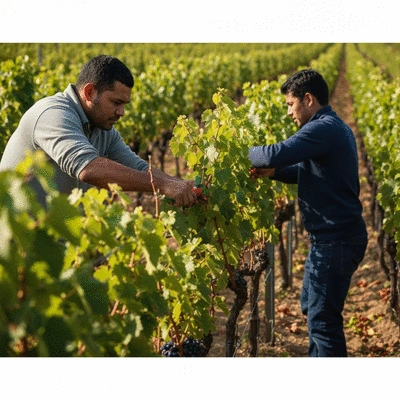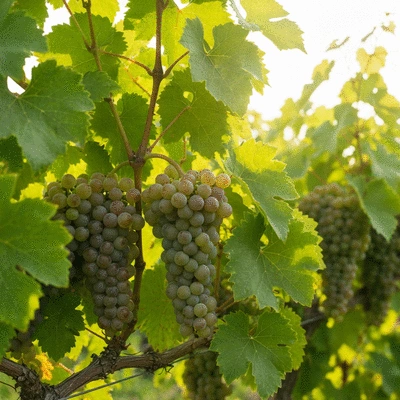Choosing the Right Australian Red Wine
By Clara Hastings / Nov 02
Did you know that the methods used in viticulture can significantly impact the sustainability of red wine? Let's explore how organic and biodynamic farming practices are transforming the landscape of winemaking for a healthier planet.
This visual highlights the core distinctions and shared benefits of organic and biodynamic farming practices in viticulture.
As a passionate wine enthusiast, I've often found myself reflecting on how our choices impact the environment. When it comes to red wine, the methods used in viticulture play a crucial role in sustainability. In this section, we’ll delve into how organic and biodynamic farming practices are shaping the future of our beloved red wines, ensuring that we can enjoy them responsibly and sustainably. For a comprehensive overview of red wine, consider reading our Australian Red Wine Basics guide.
To truly appreciate the impact of these farming methods, it’s vital to understand the differences. Organic farming focuses on methods that prioritize soil health and ecological balance without the use of synthetic pesticides and fertilizers. It’s about nurturing the land and promoting biodiversity.
Organic farming practices revolve around several key principles:
These practices not only yield grapes of higher quality but also promote a healthier ecosystem for us all!
Biodynamic farming takes organic methods a step further. It considers the vineyard as a holistic organism and incorporates these principles:
By focusing on these principles, biodynamic farmers believe they can create a more harmonious relationship between the earth and the vineyard.
While both organic and biodynamic farming are rooted in sustainability, they address different aspects. Sustainable farming focuses on practices that can be maintained over time without depleting resources. In contrast, regenerative farming aims to improve and regenerate the ecosystem actively. This means that as we adopt these methods, we’re not only preserving our environment but improving it for future generations!
Now that we've covered the basics, let’s explore the environmental benefits these practices bring to the table. Implementing organic and biodynamic methods can transform the landscape of viticulture in numerous ways.
One of the most significant impacts of organic farming is its ability to enhance soil health. By nurturing the soil with organic matter, farmers can:
This not only leads to healthier vines but also contributes to the quality of the grapes harvested. Discover more about sustainable practices in Australian wine.
Another advantage of adopting these practices is the promotion of biodiversity within vineyards. By avoiding synthetic inputs, farmers allow for a diverse ecosystem to thrive, which can lead to:
Essentially, a diverse vineyard is a healthier vineyard!
Reducing chemical inputs is a fundamental benefit of organic and biodynamic farming. The decrease in synthetic pesticides and fertilizers leads to:
This, in turn, safeguards not just the vineyard but the surrounding environment too!
Furthermore, these farming practices support ecosystem restoration. Through improved soil health and biodiversity, we can see a positive impact on carbon sequestration, helping to combat climate change. Farmers who adopt these methods are actively contributing to a healthier planet, which is something we can all toast to!
Water conservation is another critical aspect of organic and biodynamic farming. By focusing on soil health and organic matter, vineyards can:
In a world facing water scarcity, these practices are invaluable.
With a better understanding of the farming practices, it's essential to note how they affect the wines we enjoy. Let’s dive into the chemical and sensory analyses of organic and biodynamic wines.
Research shows that organic and biodynamic wines often display distinct chemical properties:
These differences can significantly impact the overall quality and flavor profile of the wine.
When it comes to tasting, organic and biodynamic wines can present a spectrum of sensory attributes. Often, they are noted for their:
This makes every sip an adventure in flavor!
Finally, let’s not forget the impact of terroir. The unique combinations of soil, climate, and vineyard practices contribute to the wine's character. Organic and biodynamic approaches often allow for a more pronounced expression of terroir, resulting in wines that are truly reflective of their origins.
To further illustrate the positive impacts of these farming practices, let’s look at some real-world examples.
Donum Estate, located in California, exemplifies the principles of biodynamic farming. Utilizing lunar cycles and careful soil management, they produce stunning Pinot Noir that showcases the unique characteristics of their vineyard. Their commitment to sustainability is not just about wine; it’s about creating a thriving ecosystem.
Across Australia, many wineries are adopting similar biodynamic practices. These regions have embraced:
The results speak for themselves: vibrant wines that reflect their environment and heritage!
Additionally, we see innovative permaculture approaches gaining traction in vineyards. These methods focus on:
This enhances not just the vineyard's productivity but also its sustainability.
As we champion organic and biodynamic wines, understanding the certification processes becomes essential. This ensures that the wines we enjoy are genuinely produced with sustainable practices.
To be labeled organic, wines must comply with rigorous standards. These include:
This certification gives consumers confidence in their choices!
For biodynamic wines, Demeter certification is key. It guarantees that the wine is produced following strict biodynamic guidelines, which include:
When you see the Demeter label, you know you’re choosing a wine that respects the earth!
In Europe, organic regulations are stringent. They ensure that wines labeled as organic meet specific criteria, impacting labeling and marketability. This not only supports consumer trust but also encourages wineries to adopt sustainable practices.
The shift towards organic and biodynamic practices is not just about sustainability; it also has economic implications. Wineries that embrace these methods often find themselves well-positioned in a growing market.
Transitioning to organic practices can require initial investment, but the long-term benefits often outweigh the costs. Wineries may experience:
It’s a win-win for both the vineyard and the planet!
Consumer perception is shifting, with an increasing number of wine lovers seeking out organic and biodynamic options. This trend is driven by a desire for:
As a result, the market for these wines is growing, providing opportunities for wineries to thrive.
The demand for organic wines has surged in recent years. As consumers become more aware of the environmental impact of their choices, they are increasingly turning to organic options, which has led to a vibrant market for these wines!
If you’re a winery owner considering the transition to organic or biodynamic farming, you’re not alone! Here are some practical steps to help guide your journey.
Transitioning to organic farming involves several steps:
This methodical approach can help ensure a smooth transition.
While the benefits of organic and biodynamic farming are numerous, challenges can arise, such as:
However, by focusing on best practices, wineries can overcome these obstacles!
One of the best ways to enhance soil health is through the use of cover crops and crop rotation. These practices allow wineries to:
This not only benefits the vineyard but also the overall ecosystem!
Did you know? When selecting your next bottle of red wine, look for wineries that not only carry organic or biodynamic certifications but also have strong community engagement initiatives. Supporting vineyards that invest in local ecosystems and community well-being enhances your wine experience while contributing positively to the environment!
Organic farming focuses on avoiding synthetic pesticides and fertilizers, promoting soil health and biodiversity. Biodynamic farming takes this further by treating the vineyard as a holistic ecosystem, incorporating lunar cycles and specific organic preparations to enhance vitality and biodiversity.
Both organic and biodynamic farming enhance soil health, promote biodiversity, reduce chemical inputs and runoff, support carbon sequestration, and improve water conservation. These benefits contribute to a healthier ecosystem and help combat climate change.
Wines produced using these methods often exhibit distinct chemical properties, such as higher antioxidant levels and lower sulfites. Sensually, they are noted for greater complexity, enhanced aroma profiles, and a stronger expression of terroir, reflecting the unique characteristics of their origin.
For organic wines, look for certifications that comply with local or national organic standards (e.g., EU Organic logo). For biodynamic wines, the Demeter certification is the international standard, ensuring adherence to strict biodynamic guidelines.
While there can be initial investments and a learning curve, many wineries find that long-term benefits, such as reduced input costs, higher prices for their wines, and increased consumer demand, outweigh the initial expenses. It's often seen as a sustainable investment.
At Red Wine Hub, we believe that embracing organic and biodynamic practices is essential for fostering a sustainable future in winemaking. These practices not only enhance the quality of the wine but also contribute significantly to the health of our planet. By prioritizing methods that respect the environment, we can ensure that wine lovers like you enjoy exceptional bottles while supporting our ecosystem!
From my experience exploring vineyards across Australia, I’ve seen firsthand how these practices can transform traditional winemaking into a more responsible craft. Not only do organic and biodynamic methods improve the soil and promote biodiversity, but they also resonate with a growing number of eco-conscious consumers. For those looking to refine their palate, consider learning how to taste red wine like an expert.
Organic and biodynamic farming goes beyond mere labels—it’s about a commitment to sustainability. These practices enhance the wine's character by focusing on natural processes, allowing grapes to express their true essence. Here are some key benefits:
As a passionate advocate for sustainable wine consumption, I invite you to consider these practices when selecting your next bottle. Supporting wineries that prioritize organic and biodynamic methods helps influence the market towards more sustainable options.
The future of winemaking is bright, thanks to advancements in organic and biodynamic farming. We’re witnessing a shift in the industry as more wineries adopt these sustainable practices, driven by a growing awareness of environmental issues. Let’s explore some potential advancements:
As we look to the future, it’s essential that we address the challenges posed by climate change through sustainable viticulture. By making informed choices and supporting these practices, we can contribute to a healthier planet for generations to come. Explore more sustainable tips for red wine to make eco-conscious choices.
Not only do we need to adapt current practices, but we must also innovate. Potential advancements in the field can significantly enhance the impact of organic and biodynamic methods on sustainability:
Climate change is a pressing issue, and sustainable viticulture offers significant benefits in this regard. By adopting organic and biodynamic practices, wine producers can:
As consumers, we hold the power to influence the wine industry. Engaging with sustainable wine choices can drive positive change. Here are some ways you can make a difference:
Every bottle you choose is a vote for the practices you believe in. Supporting sustainable practices not only leads to better wines but also encourages wineries to invest in the future of our planet. Let’s be proactive in our choices and support those who prioritize the environment!
Engaging in conversations about organic and biodynamic wines can help spread awareness and inspire others to consider the impact of their choices. Share your thoughts and experiences with friends or on social media—let's get the conversation flowing!
Finally, as part of the wine community, we can promote eco-conscious consumption. By supporting educational initiatives and sharing valuable information, we contribute to a culture that values sustainability in winemaking. So, let’s raise a glass to a greener future, one sustainable choice at a time!
Here is a quick recap of the important points discussed in the article:



 Choosing the Right Australian Red Wine
Choosing the perfect Australian red wine can significantly enhance your dining experience. Are you r
Choosing the Right Australian Red Wine
Choosing the perfect Australian red wine can significantly enhance your dining experience. Are you r
 Australia's Red Wine Regions Explored
The journey through Australia's red wine landscape is as rich and varied as the wines themselves. Ha
Australia's Red Wine Regions Explored
The journey through Australia's red wine landscape is as rich and varied as the wines themselves. Ha
 Sustainable Red Wine and the Earth
What if your wine choices could help save the planet? Sustainable red wine production not only ensur
Sustainable Red Wine and the Earth
What if your wine choices could help save the planet? Sustainable red wine production not only ensur